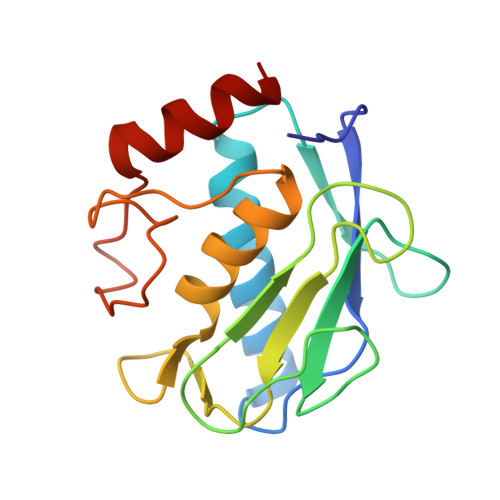Unraveling hidden regulatory sites in structurally homologous metalloproteases
Udi, Y., Fragai, M., Grossman, M., Mitternacht, S., Arad-Yellin, R., Calderone, V., Melikian, M., Toccafondi, M., Berezovsky, I.N., Luchinat, C., Sagi, I.(2013) J Mol Biol 425: 2330-2346
- PubMed: 23583775
- DOI: https://doi.org/10.1016/j.jmb.2013.04.009
- Primary Citation of Related Structures:
4IJO - PubMed Abstract:
Monitoring enzymatic activity in vivo of individual homologous enzymes such as the matrix metalloproteinases (MMPs) by antagonist molecules is highly desired for defining physiological and pathophysiological pathways. However, the rational design of antagonists targeting enzyme catalytic moieties specific to one of the homologous enzymes often appears to be an extremely difficult task. This is mainly due to the high structural homology at the enzyme active sites shared by members of the protein family. Accordingly, controlling enzymatic activity via alternative allosteric sites has become an attractive proposition for drug design targeting individual homologous enzymes. Yet, the challenge remains to identify such regulatory alternative sites that are often hidden and scattered over different locations on the protein's surface. We have designed branched amphiphilic molecules exhibiting specific inhibitory activity towards individual members of the MMP family. These amphiphilic isomers share the same chemical nature, providing versatile nonspecific binding reactivity that allows to probe hidden regulatory residues on a given protein surface. Using the advantage provided by amphiphilic ligands, here we explore a new approach for determining hidden regulatory sites. This approach includes diverse experimental analysis, such as structural spectroscopic analyses, NMR, and protein crystallography combined with computational prediction of effector binding sites. We demonstrate how our approach works by analyzing members of the MMP family that possess a unique set of such sites. Our work provides a proof of principle for using ligand effectors to unravel hidden regulatory sites specific to members of the structurally homologous MMP family. This approach may be exploited for the design of novel molecular effectors and therapeutic agents affecting protein catalytic function via interactions with structure-specific regulatory sites.
Organizational Affiliation:
Department of Biological Regulation, The Weizmann Institute of Science, Rehovot 76100, Israel.
















